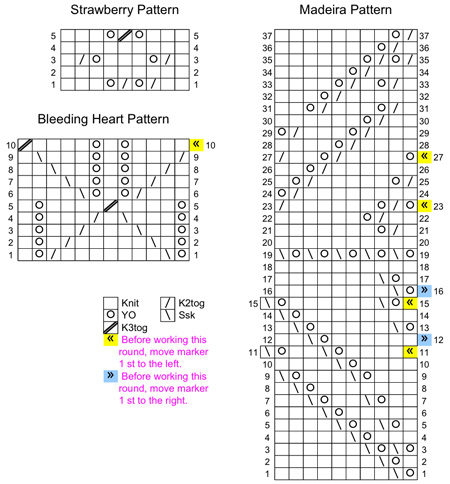Regarding
the dyes and process used:
Shipwreck
was worked with undyed yarn and dyed after the knitting
was complete in order to achieve a slightly weathered effect.
The shawl's color was achieved using approximately 3 tsp
of #80332 Sapphire Blue and 1/4 tsp of #80337 Jet Black
dissolved in a pot of simmering water on the stove. Next,
add a dollop of vinegar to the water. The more vinegar you
add now, the more variations in shade will appear in the
final shawl. For a shawl with no variations, add the vinegar
after the shawl is soaked in the dye, rather than before.
Place the completed shawl gently in the pot and submerge
it until it is thoroughly
soaked. Do not agitate,
as that could felt the
shawl! Stir slowly and
press down on the shawl
occasionally to make
sure the dye is being
absorbed by the whole
piece. Let simmer for
30 minutes or until dye
is exhausted (water is
clear). To rinse, fill a sink with clear water the
same temperature as your
simmering pot and transfer shawl to sink. Add
wool wash or your preferred
soap for cleaning wool,
and let sit. After dyeing
and rinsing, you can
block. For more details
on dyeing with acid dyes,
read this
Knitty article.


Directions for the Simple
Ring cast-on method can
be found here.
This method is also described by Thom Christoph in A Gathering of Lace (XRX
Books, 2000) on page 163.
(XRX
Books, 2000) on page 163.
Placing Beads: Beads are placed randomly thorughout work
when working Section 7 (openwork border section). Pre-string
beads on yarn before beginning border; if recommended yarn
is used at same gauge as shawl shown, beads should be strung
starting with second skein of yarn. Alternately, yarn may
be broken before beginning Section 7, then strung with beads
and reattached.
To place a bead, work a
k2tog as in pattern, then
slide a bead up the yarn
so that it sits next to
the right needle before
working a yo.
Information about blocking lace can be found here and
here.
Strawberry Pattern (Worked in the round over a multiple
of 9 sts):
Round 1: [K2, k2tog, yo,
k2tog, yo, k3] to end.
Round 2: K all sts.
Round 3: [K1, k2tog, yo,
k3, yo, k2tog, k1] to end.
Round 4: K all sts.
Round 5: [K3, yo, k3tog,
yo, k3] to end.
Bleeding Heart Pattern (Worked in the round over a multiple
of 12 sts):
Round 1: [Yo, ssk, k7,
k2tog, yo, k1] to end.
Round 2: [Yo, k1, ssk,
k5, k2tog, k1, yo, k1] to end.
Round 3: [Yo, k2, ssk,
k3, k2tog, k2, yo, k1] to end.
Round 4: [Yo, k3, ssk,
k1, k2tog, k3, yo, k1] to end.
Round 5: [Yo, k4, k3tog,
k4, yo, k1] to end.
Round 6: [K3, k2tog, yo,
k1, yo, ssk, k4] to end.
Round 7: [K2, k2tog, k1,
yo, k1, yo, k1, ssk, k3] to end.
Round 8: [K1, k2tog, k2,
yo, k1, yo, k2, ssk, k2] to end.
Round 9: [K2tog, k3, yo,
k1, yo, k3, ssk, k1] to end.
Round 10: Before beginning
this round, move marker
1 st to the left. [K4,
yo, k1, yo, k4, k3tog]
to end.
Madeira Pattern (Worked in the round over a multiple of
10 sts):
Round 1: [Yo, ssk, k8]
to end.
Round 2: [K1, yo, ssk,
k7] to end.
Round 3: [(Yo, ssk) twice,
k6] to end.
Round 4: [K3, yo, ssk,
k5] to end.
Round 5: [(K1, yo, ssk)
twice, k4] to end.
Round 6: [K5, yo, ssk,
k3] to end.
Round 7: [(K2, yo, ssk)
twice, k2] to end.
Round 8: [K7, yo, ssk,
k1] to end.
Round 9: [K3, yo, ssk]
to end.
Round 10: [K4, yo, ssk,
k4] to end.
Round 11: [Ssk, K4,
yo, ssk, k2, yo, ssk] to
end. Before
beginning this round, move
marker 1 st to the left.
Round 12: [K6, yo, ssk,
k2] to end. Before beginning
this round, move marker
1 st to the right.
Round 13: [Yo, ssk, k5,
yo, ssk, k1] to end.
Round 14: [K8, yo, ssk]
to end.
Round 15: [Ssk, yo,
ssk, k6, yo, ssk] to end. Before
beginning this round, move
marker 1 st to the left.
Round 16: [Yo, ssk, k8]
to end. Before beginning
this round, move marker
1 st to the right.
Round 17: [K1, yo, ssk,
k7] to end.
Round 18: K all sts.
Round 19: [Yo, ssk] to
end.
Round 20: K all sts.
Round 21: [K1, k2tog, yo,
k7] to end.
Round 22: [K2, k2tog, yo,
k6] to end.
Round 23: [Yo, k2tog, yo,
k6, k2tog] to end. Before
beginning this round, move marker 1 st to the left.
Round 24: [K8, k2tog, yo]
to end.
Round 25: [K2tog, yo, k5,
k2tog, yo, k1] to end.
Round 26: [K6, k2tog, yo,
k2] to end.
Round 27: [Yo, k4, k2tog,
yo, k2, k2tog] to end. Before
beginning this round, move marker 1 st to the left.
Round 28: [K4, k2tog, yo,
k4] to end.
Round 29: [K3, k2tog, yo]
to end.
Round 30: [K2, k2tog, yo, k6]
to end.
Round 31: [K1, k2tog, yo,
k3, k2tog, yo, k2] to end.
Round 32: [K5, k2tog, yo,
k3] to end.
Round 33: [(K1, k2tog,
yo) twice, k4] to end.
Round 34: [K3, k2tog, yo,
k5] to end.
Round 35: [(K2tog, yo)
twice, k6] to end.
Round 36: [K1, k2tog, yo,
k7] to end.
Round 37: [K2tog, yo, k8]
to end.
|

